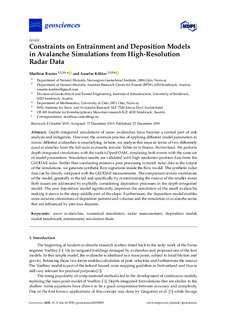Constraints on Entrainment and Deposition Models in Avalanche Simulations from High-Resolution Radar Data
Peer reviewed, Journal article
Published version
Permanent lenke
http://hdl.handle.net/11250/2636753Utgivelsesdato
2019Metadata
Vis full innførselSamlinger
- NGI articles [1061]
Sammendrag
Depth-integrated simulations of snow avalanches have become a central part of risk analysis and mitigation. However, the common practice of applying different model parameters to mimic different avalanches is unsatisfying. In here, we analyse this issue in terms of two differently sized avalanches from the full-scale avalanche test-site Vallée de la Sionne, Switzerland. We perform depth-integrated simulations with the toolkit OpenFOAM, simulating both events with the same set of model parameters. Simulation results are validated with high-resolution position data from the GEODAR radar. Rather than conducting extensive post-processing to match radar data to the output of the simulations, we generate synthetic flow signatures inside the flow model. The synthetic radar data can be directly compared with the GEODAR measurements. The comparison reveals weaknesses of the model, generally at the tail and specifically by overestimating the runout of the smaller event. Both issues are addressed by explicitly considering deposition processes in the depth-integrated model. The new deposition model significantly improves the simulation of the small avalanche, making it starve in the steep middle part of the slope. Furthermore, the deposition model enables more accurate simulations of deposition patterns and volumes and the simulation of avalanche series that are influenced by previous deposits
